Geochemical Characteristics of Garnet from Zinc–Copper Ore Bodies in the Changpo–Tongkeng Deposit and Its Geological Significance
Abstract
1. Introduction
2. Geological Setting
3. Geology of the Deposit
3.1. The Upper Tin Polymetallic Ore Bodies
3.2. The Lower Zinc–Copper Ore Bodies
4. Sampling and Analytical Methods
5. Results
5.1. Petrography Characteristics
5.2. EPMA Analysis Results
5.3. LA-ICP-MS Analysis Results
6. Discussion
6.1. Composition of REEs in Garnet and Its Significance
6.2. Characteristics of Ore Forming Based on Garnet Type
6.3. The Occurrence State of Ore-Forming Elements and Metallogenic Implications
7. Conclusions
- (1)
- Garnets in the zinc–copper ore bodies in the Changpo–Tongkeng deposit belong to the grossular–andradite solid solution series, which can be divided into two generations: an early generation (Grt I) and a late generation (Grt II). Grt I has uniform composition and no zoning. It was mainly formed in a relatively closed, near-neutral metallogenic system with low oxygen fugacity that was dominated by hydrothermal diffusion metasomatism. Grt II is andradite with well-developed oscillatory zoning, which was formed in a near-neutral system with relatively high oxygen fugacity that was dominated by infiltration metasomatism.
- (2)
- Both garnet generations are strongly depleted in LILEs and enriched in HFSEs such as Hf, Zr, Nb, and Ta; the total contents of REEs in the two generations of garnet are relatively low, showing LREE depletion and HREE enrichment patterns, and Grt II has higher REE contents than Grt I. REE3+ enters Grt I through isomorphism by replacing Ca2+ and may be influenced by both the crystal chemistry and the fluid’s physical and chemical conditions (pH, fO2). REE3+ may substitute for Ca2+ and Al3+ and enter the Grt II lattice with Mg2+.
- (3)
- The contents of Sn, As, W, In, and Ge in the garnets are relatively high and increase with an increase in the andradite component. Sn in zinc–copper ore bodies mainly exists in the form of isomorphic substitution in garnet, which may be the main reason for the lack of tin ore bodies during the skarn stage.
- (4)
- Based on the trace element analysis of garnets from domestic skarn tin (–tungsten) deposits and copper (–polymetallic) deposits, the Sn content and δEu in garnet can be used to evaluate the tin-forming potential of skarn deposits.
Author Contributions
Funding
Data Availability Statement
Acknowledgments
Conflicts of Interest
References
- Yu, F.; Shu, Q.H.; Zeng, Q.W.; Ma, X.H.; Niu, X.D.; Ma, S.L.; Li, Y.X.; Xing, K. Chemical composition of garnet from the Xintianling skarn W deposit in southern Hunan and its geological significance. Acta Petrol. Sin. 2022, 38, 78–90, (In Chinese with English abstract). [Google Scholar]
- Bian, X.L.; Zhang, J.; Wang, J.L.; Liu, C.F.; Yu, H.J. In Situ analysis of garnets from the Hongshan skarn copper deposit in Northwest Yunnan Province and its geological implications. Acta Petrol. Sin. 2019, 35, 1463–1477, (In Chinese with English abstract). [Google Scholar]
- Jamtveit, B.; Wogelius, R.A.; Fraser, D.G. Zonation patterns of skarn garnets: Records of hydrothermal system evolution. Geology 1993, 21, 113–116. [Google Scholar] [CrossRef]
- Smith, M.P.; Henderson, P.; Jeffries, T.E.R.; Long, J.; Williams, C.T. The rare earth elements and uranium in garnets from the Beinn an Dubhaich Aureole, Skye, Scotland, UK: Constraints on processes in a dynamic hydrothermal system. J. Petrol. 2004, 45, 457–484. [Google Scholar] [CrossRef]
- Gaspar, M.; Knaack, C.; Meinert, L.D.; Moretti, R. REE in skarn systems: A LA-ICP-MS study of garnets from the Crown Jewel gold deposit. Geochim. Cosmochim. Acta 2008, 72, 185–205. [Google Scholar] [CrossRef]
- Shu, Q.H.; Lai, Y.; Sun, Y.; Wang, C.; Meng, S. Ore genesis and hydrothermal evolution of the Baiyinnuo’er zinc-lead skarn deposit, Northeast China: Evidence from isotopes (S, Pb) and fluid inclusions. Econ. Geol. 2013, 108, 835–860. [Google Scholar] [CrossRef]
- Karimzadeh Somarin, A. Garnet composition as an indicator of Cu mineralization: Evidence from skarn deposits of NW Iran. J. Geochem. Explor. 2004, 81, 47–57. [Google Scholar] [CrossRef]
- Liang, T. Study on the Metallogenic Mechanism of Changpo-Tongkeng Tin-polymetallic Deposit, Dachang, Guangxi. Ph.D. Thesis, Chang’an University, Xi’an, China, 2008. (In Chinese with English abstract). [Google Scholar]
- Chen, Y.C.; Huang, M.Z.; Xu, J.; Hu, Y.Z.; Tang, S.H.; Li, Y.Q.; Meng, L.K. Geology of Dachang Tin Deposit; Geological Publishing House: Beijing, China, 1993; pp. 1–361. (In Chinese) [Google Scholar]
- Guo, J.; Zhang, R.Q.; Sun, W.D.; Ling, M.X.; Hu, Y.B.; Wu, K.; Luo, M.; Zhang, L.C. Genesis of tin-dominant polymetallic deposits in the Dachang district, South China: Insights from cassiterite U-Pb ages and trace element compositions. Ore Geol. Rev. 2018, 95, 863–879. [Google Scholar] [CrossRef]
- Wang, D.H.; Chen, Y.C.; Chen, W.; Sang, H.Q.; Li, H.Q.; Lu, Y.F.; Chen, K.L.; Lin, Z.M. Dating the Dachang Giant Tin-Polymetallic Deposit in Nandan, Guangxi. Acta Geol. Sin. 2004, 78, 132–138, (In Chinese with English abstract). [Google Scholar]
- Liang, T.; Wang, D.H.; Li, H.Q.; Huang, M.H.; Wang, D.M.; Yu, P.; Cai, M.H. REE geochemistry and Sm-Nd isotope age of garnet from the Dachang, Guangxi. J. Northwest Univ. 2011, 41, 676–681, (In Chinese with English abstract). [Google Scholar]
- Huang, W.T.; Liang, H.Y.; Zhang, J.; Wu, J.; Chen, X.L.; Ren, L. Genesis of the Dachang Sn-polymetallic and Baoshan Cu ore deposits, and formation of a Cretaceous Sn-Cu ore belt from southwest China to western Myanmar. Ore Geol. Rev. 2019, 112, 103030. [Google Scholar] [CrossRef]
- Wang, T.Y.; Li, G.J.; Wang, Q.F.; Santosh, M.; Zhang, Q.Z.; Deng, J. Petrogenesis and metallogenic implications of Late Cretaceous I- and S-type granites in Dachang-Kunlunguan ore belt, southwestern South China Block. Ore Geol. Rev. 2019, 113, 103079. [Google Scholar] [CrossRef]
- Guo, J.; Wu, K.; Seltmann, R.; Zhang, R.Q.; Ling, M.X.; Li, C.Y.; Zhang, L.P.; Sun, W.D. Unraveling the link between mantle upwelling and formation of Sn-bearing granitic rocks in the world-class Dachang tin district, South China, Geological Society of America. Bulletin 2022, 134, 1043–1064. [Google Scholar] [CrossRef]
- Cai, M.H.; Mao, J.W.; Ting, L.; Franco, P.; Huang, H.L. The origin of the Tongkeng-Changpo tin deposit, Dachang metal district, Guangxi, China: Clues from fluid inclusions and He isotope systematics. Miner. Depos. 2007, 42, 613–626. [Google Scholar] [CrossRef]
- Cai, M.H.; Peng, Z.A.; Hu, Z.S.; Li, Y. Zn, He-Ar and Sr-Nd isotopic compositions of the Tongkeng Tin-polymetallic ore deposit in south China: Implication for ore genesis. Ore Geol. Rev. 2020, 124, 103605. [Google Scholar] [CrossRef]
- Guo, J.; Zhang, G.Y.; Xiang, L.; Zhang, R.Q.; Zhang, L.P.; Sun, W.D. Combined mica and apatite chemical compositions to trace magmatic-hydrothermal evolution of fertile granites in the Dachang Sn-polymetallic district, South China. Ore Geol. Rev. 2022, 151, 105168. [Google Scholar] [CrossRef]
- Zhang, J.; Huang, W.T.; Chen, X.L.; Wu, J.; Ren, L.; Liang, H.Y.; Chen, L. Different Geochemical Characteristics and Genetic Link between Sn-polymetallic Deposit and Skarn Zn-Cu Deposit in the Dachang Ore Field, Guangxi. Geotecton. Metallog. 2019, 43, 1186–1199, (In Chinese with English abstract). [Google Scholar]
- Zhao, K.D.; Zhang, L.H.; Palmer, M.R.; Jiang, S.Y.; Xu, C.; Zhao, H.D.; Chen, W. Chemical and boron isotopic compositions of tourmaline at the Dachang Sn-polymetallic ore district in South China: Constraints on the origin and evolution of hydrothermal fluids. Miner. Depos. 2021, 56, 1589–1608. [Google Scholar] [CrossRef]
- Li, Y.Q.; Chen, W.S. The Ore-forming Fluid of Dachang Tin Deposit. Acta Petrol. Sin. 1989, 5, 12–24, (In Chinese with English abstract). [Google Scholar]
- Li, M.Q.; Shui, Z.F. Geochemical characteristics of stable isotope in Lamo zinc copper polymetallic deposit, Guangxi. Geol. Geochem. 1994, 4, 66–70, (In Chinese with English abstract). [Google Scholar]
- Li, M.Q. A Geochemical Study on The Fluid Inclusion of The Lamo Zn-Cu Polymetallic Deposit in Guangxi, China. J. Guizhou Inst. Technol. 1995, 24, 55–59, (In Chinese with English abstract). [Google Scholar]
- Fu, M.; Changkakoti, A.; Krouse, H.R.; Gray, J.; Kwak, T.A.P. An oxy-gen, hydrogen, sulfur, and carbon isotope study of carbonate-replacement (skarn) tin deposits of the Dachang tin field, China. Econ. Geol. 1991, 86, 1683–1703. [Google Scholar] [CrossRef]
- Fu, M.; Kwak, T.A.P.; Mernagh, T.P. Fluid inclusion studies of zoning in the Dachang tin-polymetallic ore field. People’s Republic China. Econ. Geol. 1993, 88, 283–300. [Google Scholar]
- Sun, S.S.; McDonough, W.F. Chemical and isotopic systematics of oceanic basalts: Implications for mantle composition and processes. Geol. Soc. Lond. Spec. Publ. 1989, 42, 313–345. [Google Scholar] [CrossRef]
- Menzer, G. XX. Die kristallstruktur der granate. Zeitschift Fur Krist. 1926, 63, 157–158. [Google Scholar] [CrossRef]
- Meinert, L.D.; Hefton, K.K.; Mayes, D.; Tasiran, I. Geology, zonation, and fluid evolution of the Big Gossan Cu-Au skarn deposit, Ertsberg district, Irian Jaya. Econ. Geol. 1997, 92, 509–534. [Google Scholar] [CrossRef]
- McIntire, W.L. Trace element partition coefficients: A review of theory and applications to geology. Geochim. Cosmochim. Acta 1963, 27, 1209–1264. [Google Scholar] [CrossRef]
- Zhao, P.L.; Yuan, S.D.; Yuan, S.D. Geochemical characteristics of garnet in the Huangshaping polymetallic deposit, southern Hunan: Implications for the genesis of Cu and W-Sn mineralization. Acta Petrol. Sin. 2018, 34, 2581–2597, (In Chinese with English abstract). [Google Scholar]
- Wen, G.; Li, J.W.; Hofstra, A.H.; Koenig, A.E.; Cui, B.Z. Textures and compositions of clinopyroxene in an Fe skarn with implications for ore-fluid evolution and mineral-fluid REE partitioning. Geochim. Cosmochim. Acta 2020, 290, 104–123. [Google Scholar] [CrossRef]
- Huang, X.D.; Lu, J.J.; Zhang, R.Q.; Sizaret, S.; Ma, D.S.; Wang, R.C.; Zhu, X.; He, Z.Y. Garnet and scheelite chemistry of the Weijia tungsten deposit, South China: Implications for fluid evolution and W skarn mineralization in F-rich ore system. Ore Geol. Rev. 2022, 142, 104729. [Google Scholar] [CrossRef]
- Enami, M.; Cong, B.; Yoshida, T.; Kawabe, I. A mechanism for Na incorporation in garnet: An example from garnet in orthogneiss from the Su-Lu Terrane, eastern China. Am. Mineral. 1995, 80, 475–482. [Google Scholar] [CrossRef]
- Sepidbar, F.; Mirnejad, H.; Li, J.W.; Wei, C.J.; George, L.L.; Burlinson, K. Mineral geochemistry of the Sangan skarn deposit, NE Iran: Implication for the evolution of hydrothermal fluid. Geochemistry 2017, 77, 399–419. [Google Scholar] [CrossRef]
- Tian, Z.D.; Leng, C.B.; Zhang, X.C.; Zafar, T.; Zhang, L.J.; Hong, W.; Lai, C.K. Chemical composition, genesis and exploration implication of garnet from the Hongshan Cu-Mo skarn deposit, SW China. Ore Geol. Rev. 2019, 112, 103016. [Google Scholar] [CrossRef]
- Hong, J.X.; Zhang, H.Y.; Li, D.F.; Ouyang, Y.P.; Zhai, D.G.; Liu, F.; Liu, J.J. In Situ LA-ICP-MS U-Pb geochronology and geochemical characteristics of garnet from the Zhuxi skarn W-Cu deposit, South China. Ore Geol. Rev. 2022, 140, 104577. [Google Scholar] [CrossRef]
- Xie, S.X.; Yang, L.Q.; He, W.Y.; Gao, X. Garnet trace element geochemistry of Yangla Cu deposit in NW Yunnan, China: Implications for multistage ore-fluid activities in skarn system. Ore Geol. Rev. 2022, 141, 104662. [Google Scholar] [CrossRef]
- Ismail, R.; Ciobanu, C.L.; Cook, N.J.; Teale, G.S.; Giles, D.; Mumm, A.S.; Wade, B. Rare earths and other trace elements in minerals from skarn assemblages, Hillside iron oxide-copper-gold deposit, Yorke Peninsula, South Australia. Lithos 2014, 184–187, 456–477. [Google Scholar] [CrossRef]
- Fei, X.H.; Zhang, Z.C.; Cheng, Z.G.; Santosh, M. Factors controlling the crystal morphology and chemistry of garnet in skarn deposits: A case study from the Cuihongshan polymetallic deposit, Lesser Xing’an Range, NE China. Am. Mineral. 2019, 104, 1455–1468. [Google Scholar] [CrossRef]
- Wood, S.A. The geochemistry of rare earth elements and yttrium in geothermal waters. Spec. Publ. Soc. Econ. Geol. 2003, 10, 133–158. [Google Scholar]
- Wang, W.; Wang, M.F.; Liu, K.; Guo, X.N. The current status and prospects of the study of garnet in skarn for hydrothermal fluid evolution tracing and mineralization zoning. Acta Petrol. Mineral. 2016, 35, 147–161, (In Chinese with English abstract). [Google Scholar]
- Dziggel, A.; Wulff, K.; Kolb, J.; Meyer, F.M.; Lahaye, Y. Significance of oscillatory and bell-shaped growth zoning in hydrothermal garnet: Evidence from the Navachab gold deposit, Namibia. Chem. Geol. 2009, 262, 262–276. [Google Scholar] [CrossRef]
- Zhai, D.G.; Liu, J.J.; Zhang, H.Y.; Wang, J.P.; Su, L.; Yang, X.A.; Wu, S.H. Origin of oscillatory zoned garnets from the Xieertala Fe-Zn skarn deposit, northern China: In situ LA-ICP-MS evidence. Lithos 2014, 190, 279–291. [Google Scholar] [CrossRef]
- Park, C.; Song, Y.; Kang, I.M.; Shim, J.; Chung, D.; Park, C.S. Metasomatic changes during periodic fluid flux recorded in grandite garnet from the Weondong W-skarn deposit, South Korea. Chem. Geol. 2017, 451, 135–153. [Google Scholar] [CrossRef]
- Xiao, X.; Zhou, T.F.; White, N.C.; Zhang, L.J.; Fan, Y.; Wang, F.Y.; Chen, X.F. The formation and trace elements of garnet in the skarn zone from the Xinqiao Cu-S-Fe-Au deposit, Tongling ore district, Anhui Province, eastern China. Lithos 2018, 302–303, 467–479. [Google Scholar] [CrossRef]
- Bau, M. Rare-earth element mobility during hydrothermal and metamorphic fluid rock interaction and the significance of the oxidation-state of europium. Chem. Geol. 1991, 93, 219–230. [Google Scholar] [CrossRef]
- Zhang, Y.; Shao, Y.J.; Wu, C.D.; Chen, H.Y. LA-ICP-MS trace element geochemistry of garnets: Constraints on hydrothermal fluid evolution and genesis of the Xinqiao Cu-S-Fe-Au deposit, eastern China. Ore Geol. Rev. 2017, 86, 426–439. [Google Scholar] [CrossRef]
- Gao, X.Q.; Sun, X.M.; Fu, Y.; Liu, Q.F. Garnet geochemistry of the giant Beiya gold-polymetallic deposit in SW China: Insights into fluid evolution during skarn formation. Ore Geol. Rev. 2022, 150, 105198. [Google Scholar] [CrossRef]
- Meinert, L.D. Skarns and skarn deposits. Geosci. Can. 1992, 19, 145–162. [Google Scholar]
- Li, Y.H.; Xie, G.Q.; Duan, C.; Han, D.; Wang, C.Y. Effect of sulfate evaporatesalt layer over the formation of skarn type iron ores. Acta Geol. Sin. 2013, 7, 1324–1334, (In Chinese with English abstract). [Google Scholar]
- Peng, H.J.; Li, H.Y.; Pei, R.F.; Zhang, C.Q.; Zhou, Y.M.; Tian, G.; Li, J.X.; Long, F. Mineralogical characteristics and metallogeny of the Hongniu-Hongshan copper de-posit in Zhongdian area, Yunnan Province, China. Acta Petrol. Sin. 2014, 30, 237–256, (In Chinese with English abstract). [Google Scholar]
- Zhu, Q.Q.; Xie, G.Q.; Li, W.; Zhang, F.; Wang, J.; Zhang, P.; Yu, B.F. In Situ analysis of garnets from the Jinshandian iron skarn deposit, Hubei Province, and its geological implications. Geol. China 2014, 41, 1944–1963, (In Chinese with English abstract). [Google Scholar]
- Xie, G.Q.; Mao, J.W.; Zhu, Q.Q.; Yao, L.; Li, Y.H.; Li, W.; Zhao, H.J. Geochemical constraints on Cu-Fe and Fe skarn deposits in the E’dong district, Middle-Lower Yangtze River metallogenic belt, China. Ore Geol. Rev. 2015, 64, 425–444. [Google Scholar] [CrossRef]
- Eadington, P.J.; Kinealy, K. Some aspects of the hydrothermal reactions of tin during skarn formation. J. Geol. Soc. Aust. 1983, 30, 461–471. [Google Scholar] [CrossRef]
- Jan, P.; Bohdan, K.; Petr, D.; Ivan, V.; Karel, Z.; Fan, D.L.; Zhang, T.; Marie-christine, B. Tin-polymetallic sulfide deposits in the eastern part of the Dachang tin field (South China) and the role of black shales in their origin. Miner. Depos. 2003, 38, 39–66. [Google Scholar]
- Jamtveit, B.; Hervig, R.L. Constraints on transport and kinetics in hydrothermal systems from zoned garnet crystals. Science 1994, 263, 505–507. [Google Scholar] [CrossRef] [PubMed]
- Mclver, J.R.; Mihalik, P. Stannian andradite from “Davib Ost”, South West Africa. Can. Miner. 1975, 13, 217–221. [Google Scholar]
- Butler, B.C.M. Tin-rich garnet, pyroxene, and spinel from a slag. Mineral. Mag. 1978, 42, 487–492. [Google Scholar] [CrossRef]
- Amthauer, G.; Mciver, J.R.; Viljoen, E.A. 57Fe and 119Sn Mössbauer studies of natural tin-bearing garnets. Phys. Chem. Miner. 1979, 4, 235–244. [Google Scholar] [CrossRef]
- Plimer, L.R. Malayaite and tin-bearing silicates from a skarn at Doradilla via Bourke, New South Wales. Aust. J. Earth Sci. 1984, 31, 147–153. [Google Scholar] [CrossRef]
- Chen, J.; Wu, H. Synthetic analogue experiments on the Shizhuyuan tungsten, tin, molybdenum and bismuth skarn deposit in southeastern Hunan province. Miner. Depos. 1988, 7, 32–41, (In Chinese with English abstract). [Google Scholar]
- Yu, F.; Shu, Q.H.; Niu, X.D.; Xing, K.; Li, L.L.; Lentz, D.R.; Zeng, Q.W.; Yang, W.J. Composition of Garnet from the Xianghualing Skarn Sn Deposit, South China: Its Petrogenetic Significance and Exploration Potential. Minerals 2020, 10, 456. [Google Scholar] [CrossRef]
- Zhou, J.H.; Feng, C.Y.; Li, D.X. Geochemistry of the garnets in the Baiganhu W-Sn orefield, NW China. Ore Geol. Rev. 2017, 82, 70–92. [Google Scholar] [CrossRef]
- Zhang, Y.P.; Shao, Y.J.; Xiong, Y.Q.; Xi, Z.J.; Lu, L.; Zhang, M.; Mao, Y.J. Metallogenic indication from geochemical characteristics of garnet in Gejiu Sn-Cu ore-concentrated area, Yunnan Province. Miner. Depos. 2022, 41, 682–701, (In Chinese with English abstract). [Google Scholar]
- Yang, W.Q.; Zheng, X.J.; Yang, G.S.; Yan, Y.F.; Sun, B. The geological significance of vesuvianite in the Heishuigou Zn-Cu deposit in the Dachang area, Guangxi Autonomous Region, China. Acta Mineral. Sin. 2022, 42, 193–202, (In Chinese with English abstract). [Google Scholar]
- Xu, J.; Ciobanu, C.L.; Cook, N.J.; Zheng, Y.Y.; Sun, X.; Wade, B.P. Skarn formation and trace elements in garnet and associated minerals from Zhibula copper deposit, Gangdese Belt, southern Tibet. Lithos 2016, 262, 213–231. [Google Scholar] [CrossRef]
- Li, X.F.; Zhu, Y.T.; Xu, J. Indium as a critical mineral: A research progress report. Chin. Sci. Bull. 2020, 65, 3678–3687, (In Chinese with English abstract). [Google Scholar] [CrossRef]
- Taylor, S.R.; Mclennan, S.M. The continental crust: Its composition and evolution. J. Geol. 1985, 94, 57–72. [Google Scholar]
- Wu, Y.T. Study on the Enrichment Regularity of Indium in Dachang Ore-Field, Guangxi. Ph.D. Thesis, Central South University, Changsha, China, 2009. (In Chinese with English abstract). [Google Scholar]
- Zhang, H. Geochemical Characteristics of Sphalerite and Zn Isotope Study in Tongkeng Tin Polymetallic Deposit, Dachang, Guangxi. Master’s Thesis, Guangxi University, Guangxi, China, 2019. (In Chinese with English abstract). [Google Scholar]
- Wilson, G.A.; Eugster, H.P. Cassiterite solubility and tin speciation in supercritical chloride solutions. Geochem. Soc. Spec. Publ. 1990, 2, 179–195. [Google Scholar]
- Wang, L.J.; Wang, J.B.; Wang, Y.W.; Long, L.L. Metallogenic mechasim of fluid and prospecting forecast of Dajing Sn-Cu polymetallic deposit, Inner Mongolia. Acta Petrol. Sin. 2015, 31, 991–1001, (in Chinese with English abstract). [Google Scholar]
- Zhang, R.Q.; Lu, J.J.; Lehmann, B.; Li, C.Y.; Li, G.L.; Zhang, L.P.; Guo, J.; Sun, W.D. Combined zircon and cassiterite U-Pb dating of the Piaotang granite-related tungsten-tin deposit, southern Jiangxi tungsten district, China. Ore Geol. Rev. 2017, 82, 268–284. [Google Scholar] [CrossRef]
- Schmidt, C. Formation of hydrothermal tin deposits: Raman spectroscopic evidence for an important role of aqueous Sn (IV) species. Geochim. Cosmochim. Acta 2018, 220, 499–511. [Google Scholar] [CrossRef]
- Yuan, S.D.; Zhao, P.L.; Liu, M. Some problems involving in petrogenesis and metallogenesis of granite-related tin deposits. Miner. Depos. 2020, 39, 607–618, (In Chinese with English abstract). [Google Scholar]
- Liu, X.C.; Yu, P.P.; Xiao, C.H. Tin transport and cassiterite precipitation from hydrothermal fluids. Geosci. Front. 2023, 14, 101624. [Google Scholar] [CrossRef]
- Chu, G.B.; Chen, H.Y.; Zhang, S.T.; Zhang, Y.; Chen, J.M. Geochemistry and geochronology of multi-generation garnet: Newinsights on the genesis and fluid evolution of prograde skarn formation. Geosci. Front. 2023, 14, 101495. [Google Scholar] [CrossRef]
- Ouyang, Y.P.; Zhou, X.R.; Yao, Z.Y.; Rao, J.F.; Song, S.W.; Wei, J.; Lu, Y. Study on the two stage garnets and their indication of mineralization in the Zhuxi W(Cu) deposit, northeastern Jiangxi Province. Earth Sci. Front. 2020, 27, 219–231, (In Chinese with English abstract). [Google Scholar]
- Fan, X.J.; Wang, X.D.; Lv, X.B.; Wei, W.; Chen, W. Garnet composition as an indicator of skarn formation: LA-ICP-MS and EPMA studies on oscillatory zoned garnets from the Haobugao skarn deposit, Inner Mongolia, China. Geol. J. 2019, 54, 1976–1992. [Google Scholar] [CrossRef]
- Tian, M.J.; Li, X.C.; Guo, J.H.; Li, Y.G.; Zhang, Y. Composition of garnet from the Yongping Cu skarn deposit, South China: Implication for ore-fluid evolution. Ore Geol. Rev. 2021, 139, 104585. [Google Scholar] [CrossRef]
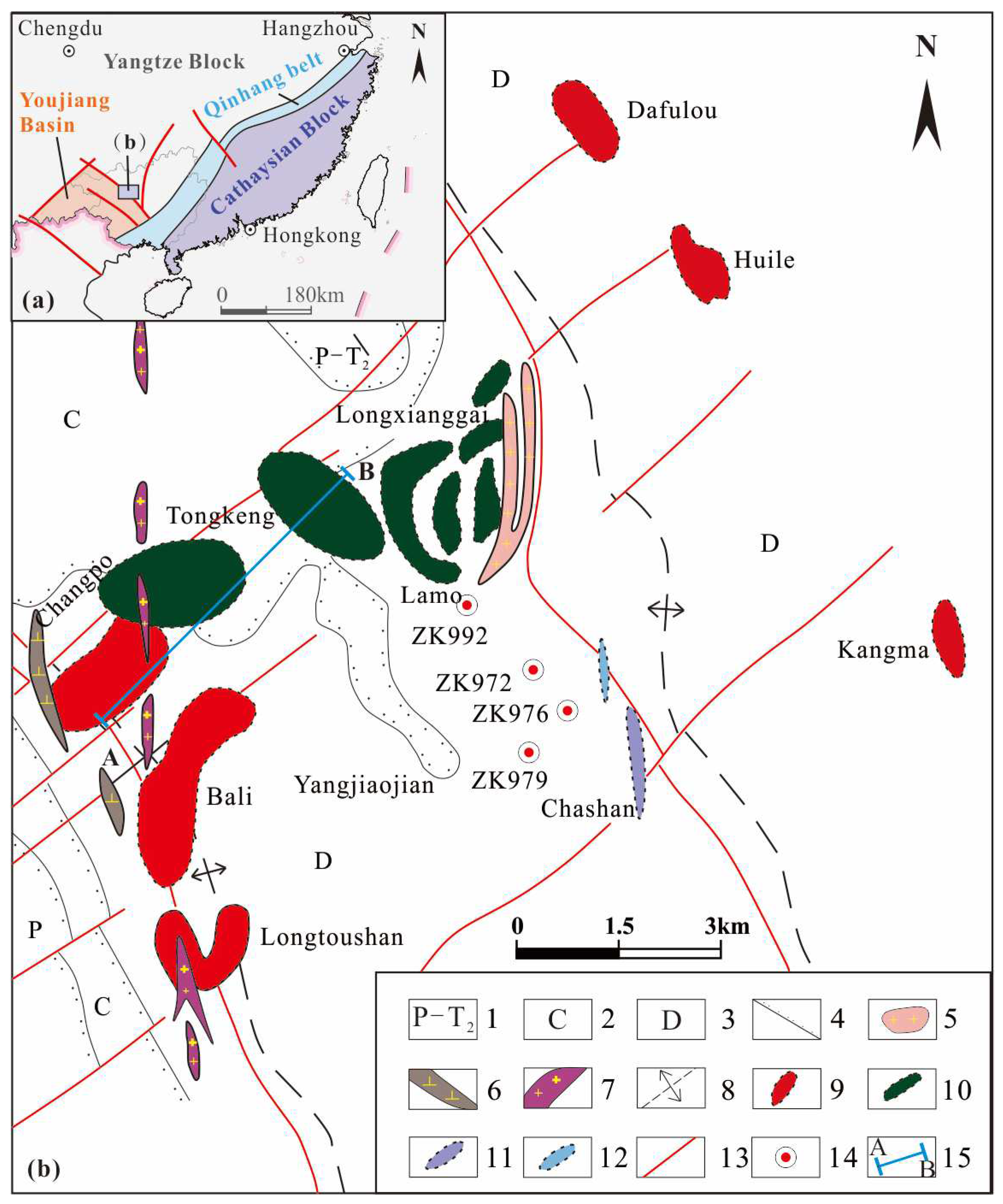
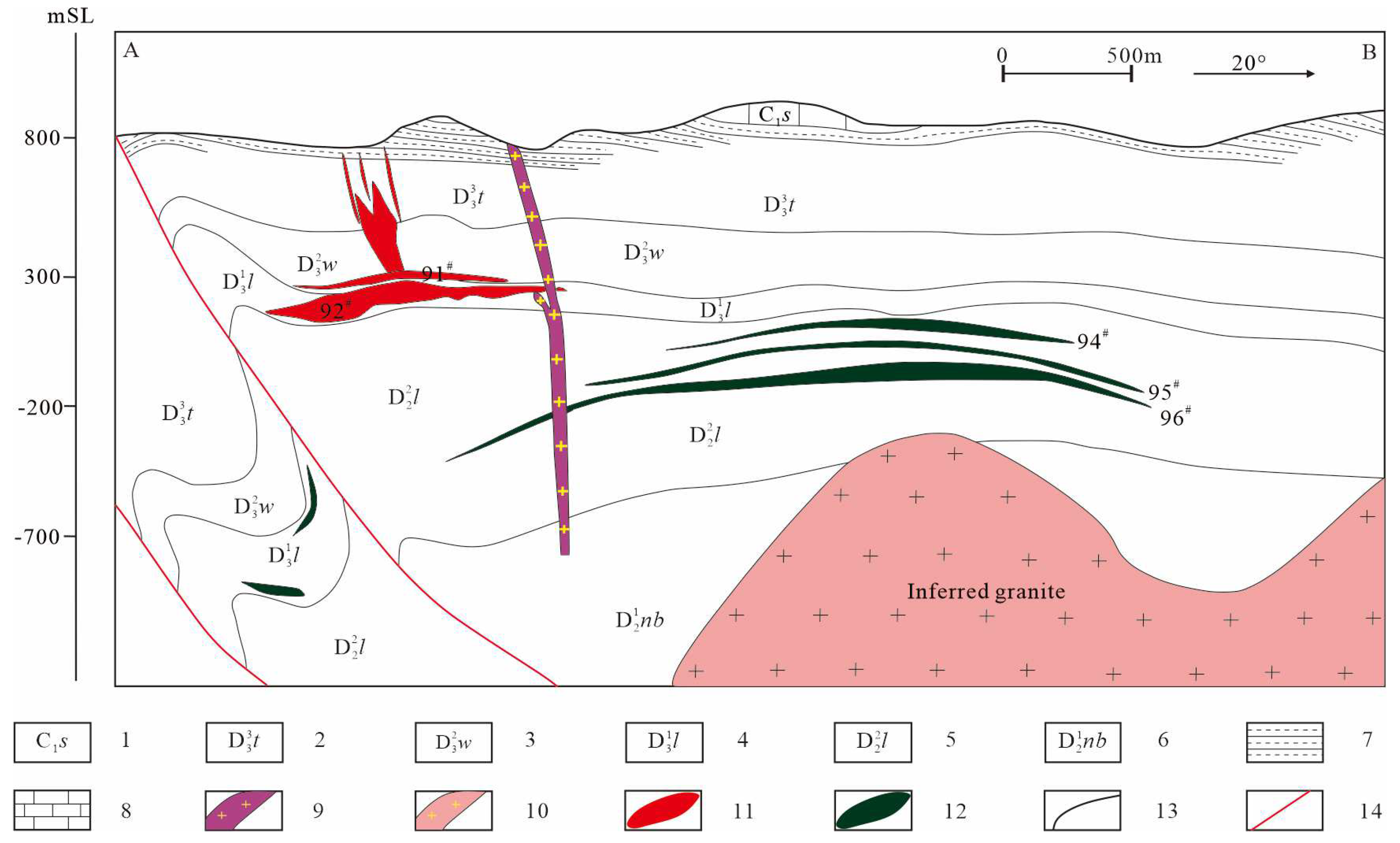
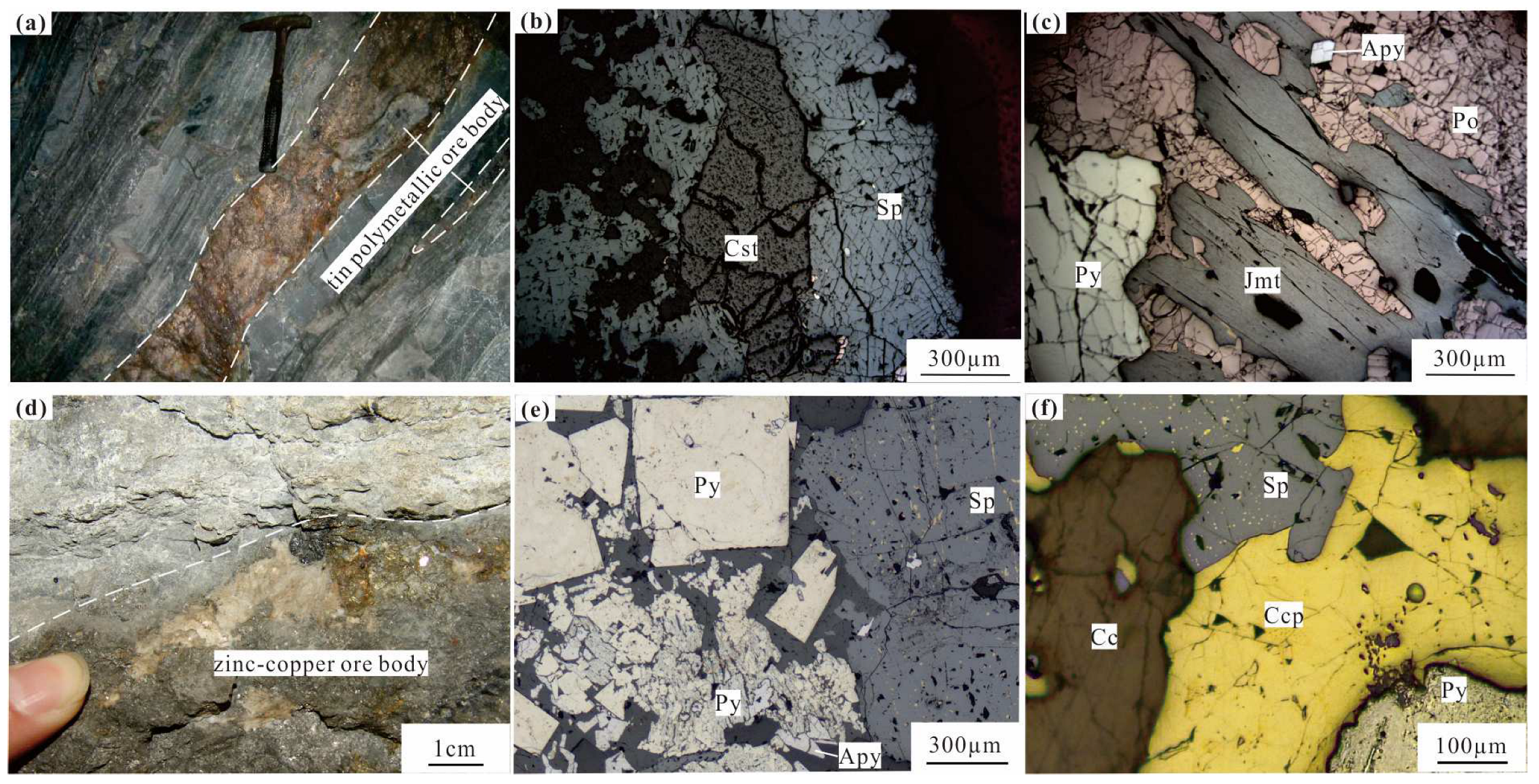


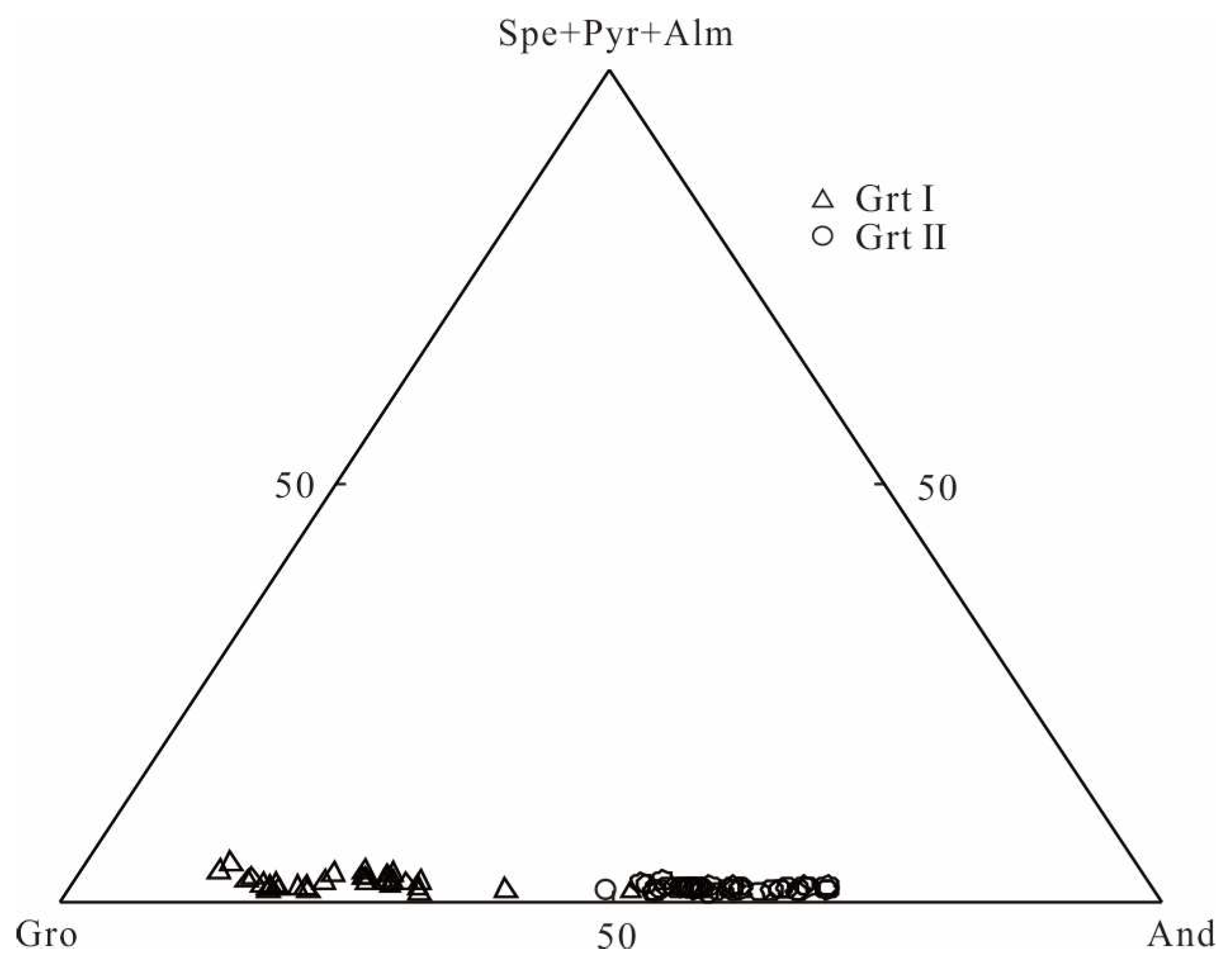

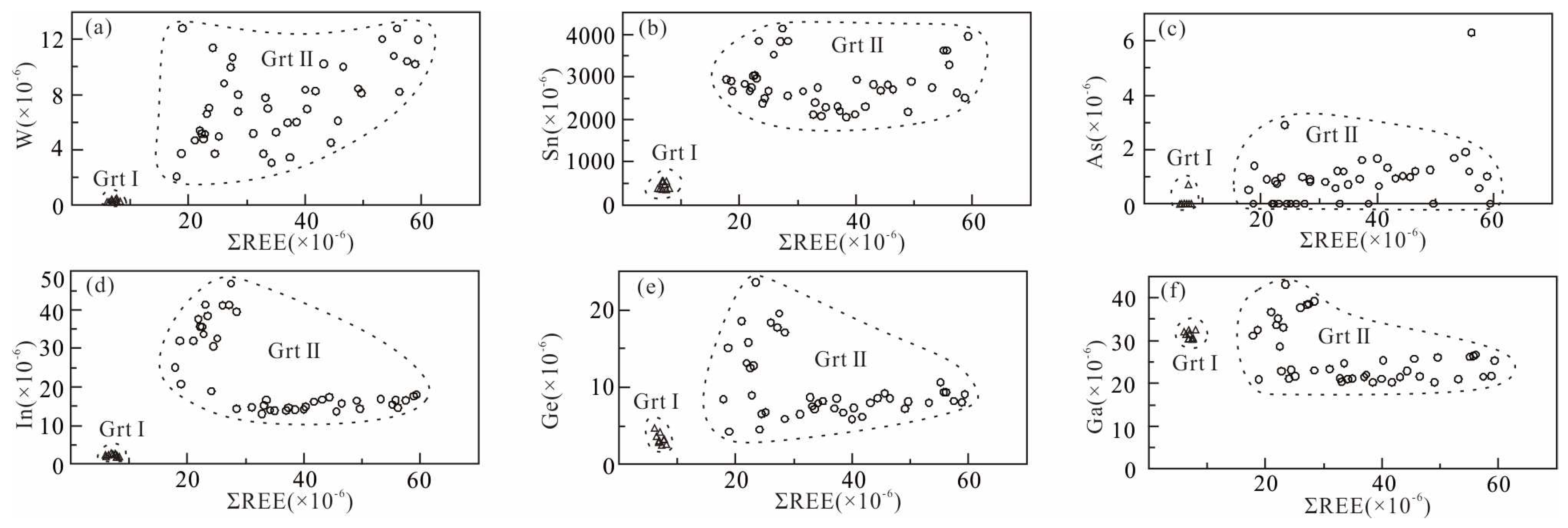


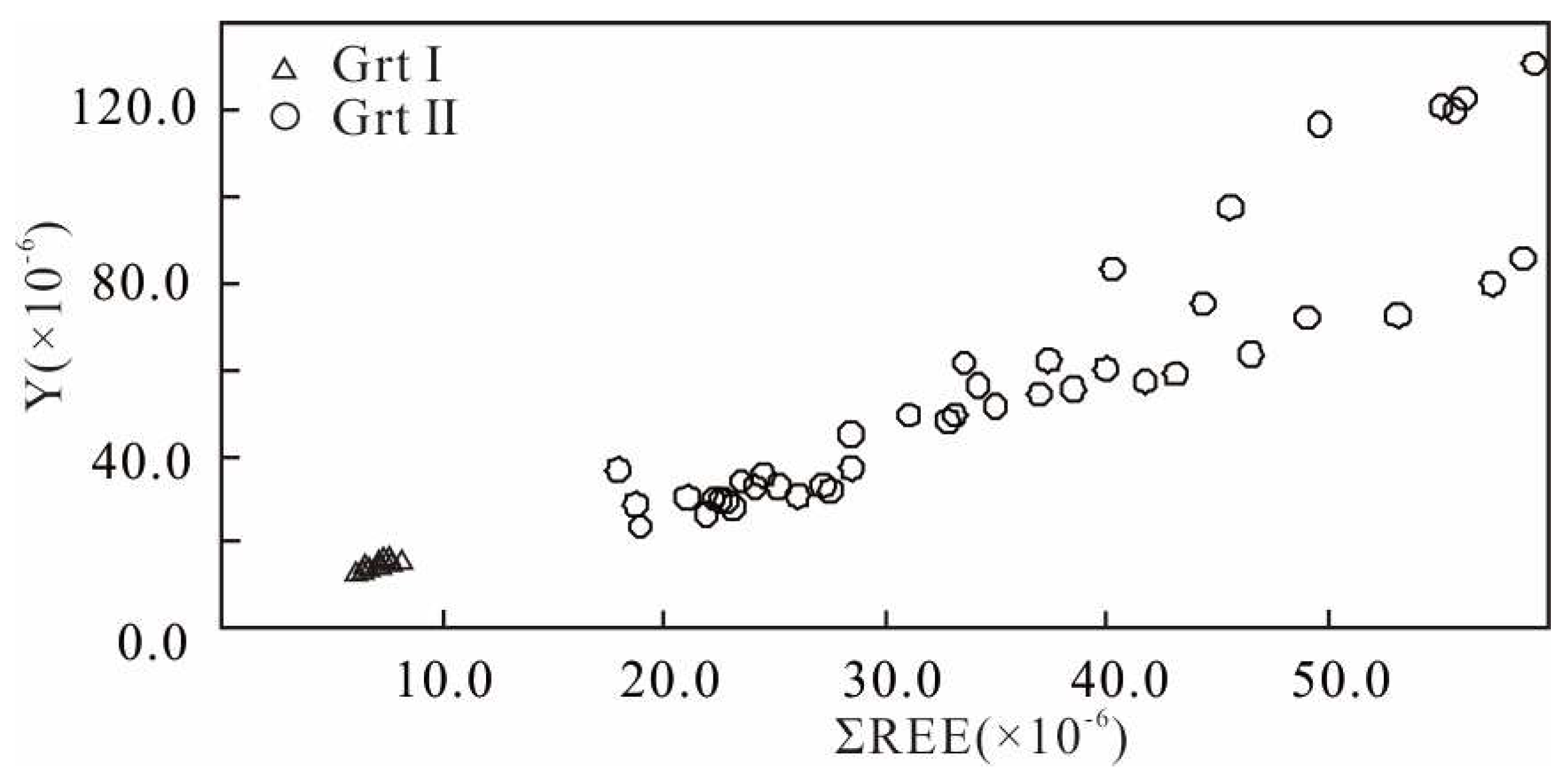
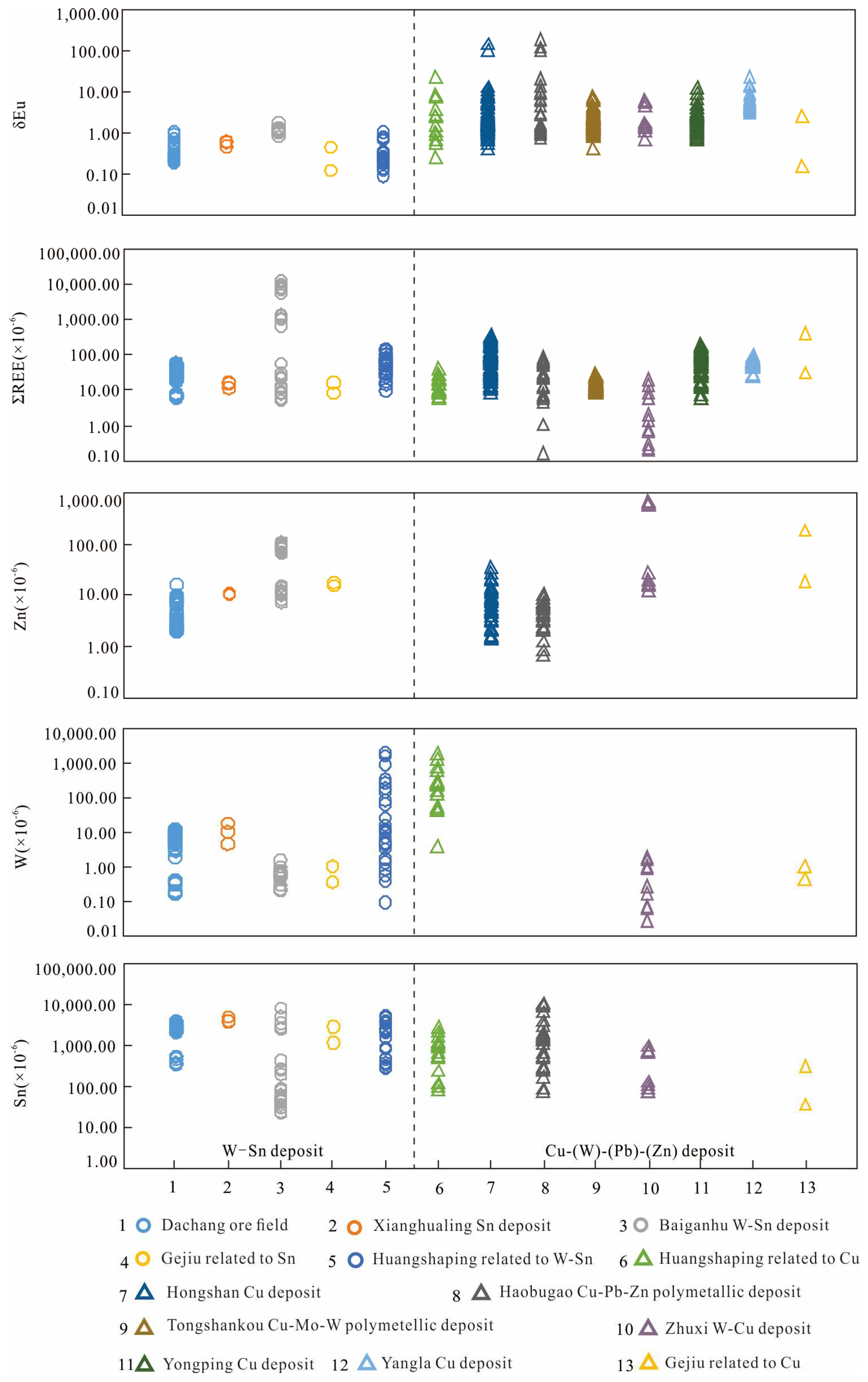
| Sample | 1511-5-1 (N = 4) | 1511-19-1 (N = 5) | 1511-19-2 (N = 5) | 1511-19-3 (N = 3) | 1511-8-1 | ||||||||
| Max. | Min. | Avg. | Max. | Min. | Avg. | Max. | Min. | Avg. | Max. | Min. | Avg. | Max. | |
| Generation | Grt I | ||||||||||||
| SiO2 | 38.11 | 37.44 | 37.81 | 39.11 | 38.25 | 38.72 | 38.95 | 38.37 | 38.62 | 39.31 | 38.25 | 38.67 | 38.94 |
| TiO2 | 0.74 | 0.16 | 0.43 | 0.39 | 0.24 | 0.3 | 0.73 | 0.01 | 0.55 | 0.74 | 0.24 | 0.56 | 0.13 |
| Al2O3 | 15.86 | 10.47 | 14.08 | 18.98 | 17.94 | 18.68 | 19 | 18.47 | 18.76 | 19.08 | 17.13 | 18.36 | 16.39 |
| Cr2O3 | b.d.l. | b.d.l. | b.d.l. | 0.14 | b.d.l. | 0.04 | 0.09 | b.d.l. | 0.04 | 0.08 | 0.02 | 0.05 | 0.05 |
| FeO | 15.54 | 8.1 | 10.59 | 6.9 | 5.4 | 6 | 6.17 | 5.47 | 5.78 | 7.22 | 4.97 | 5.74 | 9.33 |
| MnO | 0.97 | 0.66 | 0.79 | 1.23 | 0.66 | 0.84 | 0.89 | 0.6 | 0.73 | 1.45 | 0.6 | 0.91 | 1.22 |
| MgO | 0.04 | 0.01 | 0.02 | 0.04 | 0.02 | 0.03 | 0.07 | 0.03 | 0.04 | 0.05 | 0.04 | 0.05 | 0.07 |
| CaO | 35.81 | 34.46 | 35.35 | 35.76 | 35.1 | 35.51 | 35.79 | 35.09 | 35.44 | 35.84 | 34.74 | 35.43 | 35.44 |
| Na2O | 0.01 | b.d.l. | b.d.l. | 0.01 | b.d.l. | b.d.l. | 0.01 | b.d.l. | b.d.l. | 0.01 | b.d.l. | 0.01 | 0.02 |
| K2O | b.d.l. | b.d.l. | b.d.l. | 0.02 | b.d.l. | 0.01 | 0.01 | b.d.l. | b.d.l. | 0.01 | b.d.l. | 0.01 | 0.04 |
| SnO2 | 0.2 | 0.07 | 0.11 | 0.05 | b.d.l. | 0.03 | 0.06 | b.d.l. | 0.02 | 0.02 | b.d.l. | 0.01 | 0.08 |
| Total | 99.71 | 98.91 | 99.2 | 100.57 | 99.73 | 100.15 | 100.46 | 99.46 | 99.99 | 100.57 | 99.38 | 99.79 | 100.94 |
| Spe | 2.11 | 1.45 | 1.74 | 2.67 | 1.42 | 1.81 | 1.9 | 1.29 | 1.57 | 3.16 | 1.28 | 1.97 | 2.69 |
| And | 50.2 | 31.45 | 38.4 | 22.42 | 15.53 | 18.94 | 21.04 | 12.9 | 17.15 | 22.9 | 12.25 | 17.71 | 30.15 |
| Gro | 66.93 | 46.47 | 59.69 | 81.25 | 73.64 | 77.66 | 80.89 | 75.26 | 79.06 | 81.75 | 72.79 | 78.15 | 70 |
| Sample | 1511-8-1 (N = 4) | 1511-8-2 (N = 5) | 1511-8-3 (N = 5) | 1511-6-1 (N = 9) | 1511-6-2 (N = 6) | ||||||||
| Min. | Avg. | Max. | Min. | Avg. | Max. | Min. | Avg. | Max. | Min. | Avg. | Max. | Min. | |
| Generation | Grt I | Grt II | |||||||||||
| SiO2 | 38.36 | 38.58 | 38.61 | 38.07 | 38.24 | 38.73 | 38.16 | 38.37 | 37.65 | 36.71 | 37.15 | 37.3 | 36.72 |
| TiO2 | 0.07 | 0.1 | 0.15 | 0.03 | 0.1 | 0.21 | 0.09 | 0.16 | 0.35 | 0.12 | 0.25 | 0.37 | 0.26 |
| Al2O3 | 15.52 | 16.11 | 19.05 | 15.86 | 16.64 | 18.55 | 16.21 | 16.88 | 11.25 | 8.86 | 10.02 | 10.89 | 9.04 |
| Cr2O3 | b.d.l. | 0.01 | 0.07 | b.d.l. | 0.02 | 0.13 | b.d.l. | 0.04 | 0.13 | b.d.l. | 0.04 | 0.08 | b.d.l. |
| FeO | 8.03 | 8.61 | 9.09 | 5.2 | 7.87 | 8.31 | 6.05 | 7.75 | 18.49 | 14.9 | 16.13 | 16.15 | 14.13 |
| MnO | 1.01 | 1.1 | 1.23 | 0.84 | 1.04 | 1.19 | 0.82 | 1.02 | 0.97 | 0.48 | 0.76 | 1.16 | 0.66 |
| MgO | 0.03 | 0.05 | 0.07 | 0.03 | 0.06 | 0.08 | 0.04 | 0.05 | 0.04 | 0.01 | 0.03 | 0.03 | 0.01 |
| CaO | 34.54 | 35.07 | 35.59 | 34.43 | 34.89 | 35.35 | 34.92 | 35.1 | 34.95 | 33.96 | 34.6 | 34.62 | 34.29 |
| Na2O | b.d.l. | 0.01 | 0.01 | b.d.l. | b.d.l. | 0.02 | b.d.l. | b.d.l. | b.d.l. | b.d.l. | b.d.l. | 0.01 | b.d.l. |
| K2O | b.d.l. | 0.01 | b.d.l. | b.d.l. | b.d.l. | 0.01 | b.d.l. | b.d.l. | 0.01 | b.d.l. | b.d.l. | 0.02 | b.d.l. |
| SnO2 | b.d.l. | 0.05 | 0.09 | 0.02 | 0.04 | 0.09 | b.d.l. | 0.05 | 0.45 | 0.1 | 0.32 | 0.29 | 0.03 |
| Total | 98.52 | 99.71 | 99.47 | 97.87 | 98.9 | 99.63 | 99.3 | 99.43 | 99.97 | 98.25 | 99.3 | 99.14 | 97.74 |
| Spe | 2.22 | 2.39 | 2.71 | 1.82 | 2.28 | 2.6 | 1.77 | 2.23 | 2.15 | 1.09 | 1.71 | 2.58 | 1.49 |
| And | 25.57 | 28.29 | 31.08 | 18.68 | 26.48 | 28.73 | 20.27 | 25.86 | 65.76 | 52.12 | 56.95 | 57.4 | 48.4 |
| Gro | 66.85 | 68.35 | 78.46 | 65.27 | 70.15 | 76.06 | 68.25 | 70.82 | 45.85 | 31.05 | 40.94 | 49.34 | 41.45 |
| Sample | 1511-6-2 | 1507-20-1 (N = 5) | 1507-20-2 (N = 5) | 1507-20-3 (N = 6) | 1507-20-4 (N = 7) | ||||||||
| Avg. | Max. | Min. | Avg. | Max. | Min. | Avg. | Max. | Min. | Avg. | Max. | Min. | Avg. | |
| Generation | Grt II | ||||||||||||
| SiO2 | 37.06 | 37.08 | 36.69 | 36.94 | 37.15 | 36.57 | 36.83 | 37.68 | 36.34 | 36.86 | 36.92 | 36.04 | 36.56 |
| TiO2 | 0.31 | 0.36 | 0.05 | 0.15 | 0.34 | 0.05 | 0.21 | 0.19 | 0.05 | 0.12 | 0.43 | 0.13 | 0.22 |
| Al2O3 | 10.27 | 10.71 | 9.26 | 9.83 | 9.14 | 7.91 | 8.62 | 11.53 | 8.3 | 9.17 | 10.29 | 7.97 | 9.01 |
| Cr2O3 | 0.03 | 0.12 | b.d.l. | 0.03 | 0.12 | b.d.l. | 0.06 | 0.1 | b.d.l. | 0.05 | 0.14 | b.d.l. | 0.04 |
| FeO | 15.23 | 16.78 | 14.59 | 16.05 | 18.23 | 16.72 | 17.43 | 18.67 | 14.1 | 16.73 | 18.01 | 15.09 | 16.97 |
| MnO | 0.83 | 0.76 | 0.61 | 0.69 | 0.66 | 0.48 | 0.57 | 1.04 | 0.51 | 0.75 | 0.89 | 0.51 | 0.65 |
| MgO | 0.02 | 0.03 | 0.02 | 0.02 | 0.05 | 0.01 | 0.02 | 0.05 | 0.02 | 0.03 | 0.06 | 0.02 | 0.04 |
| CaO | 34.46 | 35.03 | 34.14 | 34.64 | 34.84 | 34.17 | 34.58 | 34.88 | 33.62 | 34.31 | 34.7 | 34.12 | 34.46 |
| Na2O | b.d.l. | b.d.l. | b.d.l. | b.d.l. | 0.02 | b.d.l. | b.d.l. | 0.02 | 0.01 | 0.01 | 0.01 | b.d.l. | b.d.l. |
| K2O | 0.01 | 0.01 | b.d.l. | 0.01 | 0.01 | b.d.l. | b.d.l. | 0.04 | b.d.l. | 0.02 | 0.02 | b.d.l. | 0.01 |
| SnO2 | 0.16 | 0.35 | 0.2 | 0.27 | 0.55 | 0.18 | 0.36 | 0.27 | 0.01 | 0.15 | 0.43 | 0.19 | 0.28 |
| Total | 98.36 | 99.24 | 97.77 | 98.64 | 99.44 | 97.99 | 98.68 | 99.4 | 97.39 | 98.2 | 99.32 | 97.26 | 98.23 |
| Spe | 1.87 | 1.71 | 1.39 | 1.56 | 1.48 | 1.1 | 1.29 | 2.29 | 1.16 | 1.69 | 1.97 | 1.16 | 1.47 |
| And | 53.93 | 64.6 | 56.02 | 58.96 | 66.68 | 58.54 | 63.22 | 66.17 | 51.52 | 60.54 | 69.06 | 53.65 | 63.41 |
| Gro | 44.02 | 42.69 | 33.65 | 39.37 | 40.62 | 32.07 | 35.41 | 45.9 | 30.69 | 37.5 | 45.48 | 29.24 | 34.98 |
| Sample | 1511-19-1 (N = 5) | 1511-19-2 (N = 5) | 1511-6-1 (N = 15) | 1507-20-4 (N = 28) | ||||||||
| Max. | Min. | Avg. | Max. | Min. | Avg. | Max. | Min. | Avg. | Max. | Min. | Avg. | |
| Generation | Grt I | Grt II | ||||||||||
| Sn | 372.42 | 340.11 | 357.02 | 539.05 | 466.19 | 521.02 | 4137.47 | 2051.14 | 2828.50 | 3953.07 | 2051.14 | 2650.02 |
| B | 15.45 | 7.74 | 9.87 | 12.67 | 7.99 | 9.98 | 19.75 | 9.64 | 13.70 | 17.57 | 9.64 | 13.45 |
| Cl | 483.37 | b.d.l. | 244.25 | b.d.l. | b.d.l. | b.d.l. | 407.85 | b.d.l. | 130.67 | 407.85 | b.d.l. | 170.51 |
| Sc | 13.27 | 7.59 | 9.37 | 9.38 | 5.39 | 6.85 | 66.78 | 4.82 | 17.99 | 66.78 | 4.82 | 26.49 |
| V | 316.24 | 225.44 | 278.01 | 287.26 | 179.29 | 217.36 | 505.70 | 71.29 | 198.87 | 505.70 | 71.29 | 276.57 |
| Cr | 20.20 | 10.08 | 14.02 | 36.08 | 19.56 | 25.17 | 674.07 | b.d.l. | 92.07 | 674.07 | 15.36 | 140.35 |
| Zn | 9.14 | 6.96 | 7.86 | 10.04 | 8.21 | 8.93 | 16.50 | 1.95 | 3.29 | 16.50 | 1.95 | 3.22 |
| Ga | 32.47 | 30.27 | 31.68 | 31.52 | 30.12 | 30.58 | 43.08 | 20.26 | 26.27 | 26.71 | 20.26 | 22.66 |
| Ge | 4.65 | 2.60 | 3.35 | 4.10 | 2.56 | 3.09 | 23.60 | 4.24 | 10.00 | 10.62 | 4.24 | 7.68 |
| As | b.d.l. | b.d.l. | b.d.l. | 0.71 | b.d.l. | 0.14 | 6.31 | b.d.l. | 0.92 | 6.31 | b.d.l. | 1.21 |
| Sr | 0.12 | 0.03 | 0.08 | 0.12 | 0.02 | 0.07 | 0.53 | b.d.l. | 0.07 | 0.53 | b.d.l. | 0.07 |
| Zr | 20.61 | 15.54 | 18.20 | 30.39 | 26.48 | 29.10 | 101.13 | 42.41 | 68.58 | 101.13 | 42.41 | 75.99 |
| Nb | 5.20 | 2.51 | 3.88 | 6.15 | 4.33 | 5.43 | 7.96 | 0.45 | 4.90 | 7.96 | 0.45 | 4.27 |
| In | 2.09 | 1.80 | 1.94 | 2.59 | 2.43 | 2.53 | 46.80 | 13.04 | 22.84 | 20.75 | 13.04 | 15.68 |
| Sb | b.d.l. | b.d.l. | b.d.l. | b.d.l. | b.d.l. | b.d.l. | 0.45 | b.d.l. | 0.16 | 0.38 | b.d.l. | 0.15 |
| Hf | 1.69 | 1.08 | 1.35 | 1.72 | 1.60 | 1.65 | 2.48 | 0.62 | 1.62 | 2.48 | 0.62 | 1.89 |
| Ta | 0.83 | 0.12 | 0.43 | 0.38 | 0.22 | 0.29 | 0.69 | 0.02 | 0.32 | 0.51 | 0.02 | 0.25 |
| W | 0.21 | 0.17 | 0.19 | 0.44 | 0.33 | 0.39 | 12.81 | 3.05 | 7.36 | 12.81 | 3.05 | 8.06 |
| Th | b.d.l. | b.d.l. | b.d.l. | b.d.l. | b.d.l. | b.d.l. | 0.76 | 0.05 | 0.20 | 0.76 | 0.05 | 0.29 |
| U | 0.01 | b.d.l. | b.d.l. | 0.003 | b.d.l. | b.d.l. | 0.84 | 0.19 | 0.34 | 0.84 | 0.19 | 0.39 |
| La | 0.003 | b.d.l. | b.d.l. | 0.01 | b.d.l. | b.d.l. | 0.22 | 0.02 | 0.04 | 0.22 | 0.02 | 0.05 |
| Ce | 0.01 | b.d.l. | 0.01 | 0.02 | 0.01 | 0.01 | 1.11 | 0.32 | 0.49 | 1.11 | 0.32 | 0.61 |
| Pr | 0.01 | b.d.l. | b.d.l. | 0.01 | b.d.l. | 0.01 | 0.74 | 0.19 | 0.32 | 0.74 | b.d.l. | 0.39 |
| Nd | 0.11 | 0.01 | 0.07 | 0.11 | 0.04 | 0.07 | 9.69 | 3.00 | 4.49 | 9.69 | 3.00 | 5.31 |
| Sm | 0.10 | b.d.l. | 0.06 | 0.13 | 0.05 | 0.10 | 7.73 | 2.66 | 4.17 | 7.73 | 2.66 | 4.57 |
| Eu | 0.06 | 0.02 | 0.04 | 0.07 | b.d.l. | 0.04 | 0.67 | 0.32 | 0.44 | 0.67 | 0.32 | 0.49 |
| Gd | 0.32 | 0.22 | 0.27 | 0.50 | 0.39 | 0.44 | 11.29 | 3.74 | 6.78 | 11.29 | 3.74 | 7.53 |
| Tb | 0.13 | 0.08 | 0.10 | 0.15 | 0.12 | 0.13 | 1.82 | 0.56 | 1.14 | 1.82 | 0.56 | 1.31 |
| Dy | 1.44 | 1.10 | 1.29 | 1.66 | 1.39 | 1.51 | 13.09 | 3.15 | 7.55 | 13.09 | 3.15 | 9.02 |
| Ho | 0.47 | 0.39 | 0.43 | 0.51 | 0.41 | 0.46 | 3.35 | 0.65 | 1.58 | 3.35 | 0.65 | 1.97 |
| Er | 2.12 | 1.43 | 1.69 | 1.88 | 1.62 | 1.75 | 10.51 | 1.70 | 4.40 | 10.51 | 1.70 | 5.55 |
| Tm | 0.37 | 0.28 | 0.32 | 0.30 | 0.25 | 0.28 | 1.47 | 0.18 | 0.55 | 1.47 | 0.18 | 0.70 |
| Yb | 2.80 | 1.95 | 2.33 | 2.24 | 1.85 | 2.05 | 8.69 | 1.14 | 3.20 | 8.69 | 1.14 | 4.05 |
| Lu | 0.46 | 0.33 | 0.37 | 0.34 | 0.25 | 0.29 | 1.12 | 0.16 | 0.43 | 1.12 | 0.16 | 0.54 |
| Y | 15.91 | 13.04 | 14.44 | 15.83 | 14.89 | 15.22 | 130.60 | 23.65 | 57.59 | 130.60 | 23.65 | 71.53 |
| ΣREE | 8.01 | 6.02 | 6.98 | 7.53 | 6.78 | 7.13 | 59.30 | 18.84 | 35.58 | 59.30 | 18.84 | 42.08 |
| LREE | 0.25 | 0.10 | 0.18 | 0.27 | 0.17 | 0.22 | 19.94 | 7.14 | 9.95 | 19.94 | 7.14 | 11.42 |
| HREE | 7.91 | 5.84 | 6.81 | 7.26 | 6.62 | 6.91 | 48.82 | 11.29 | 25.63 | 48.82 | 11.29 | 30.66 |
| LREE/HREE | 0.03 | 0.01 | 0.02 | 0.04 | 0.03 | 0.03 | 0.67 | 0.17 | 0.41 | 0.67 | 0.17 | 0.40 |
| δEu | 0.94 | 0.47 | 0.67 | 0.89 | b.d.l. | 0.58 | 0.29 | 0.18 | 0.24 | 0.44 | 0.18 | 0.26 |
| δCe | 0.62 | 0.50 | 0.57 | 0.71 | 0.24 | 0.50 | 0.49 | 0.32 | 0.40 | 0.55 | 0.40 | 0.47 |
Disclaimer/Publisher’s Note: The statements, opinions and data contained in all publications are solely those of the individual author(s) and contributor(s) and not of MDPI and/or the editor(s). MDPI and/or the editor(s) disclaim responsibility for any injury to people or property resulting from any ideas, methods, instructions or products referred to in the content. |
© 2023 by the authors. Licensee MDPI, Basel, Switzerland. This article is an open access article distributed under the terms and conditions of the Creative Commons Attribution (CC BY) license (https://creativecommons.org/licenses/by/4.0/).
Share and Cite
He, L.; Liang, T.; Wang, D.; Zhao, Z.; Liu, B.; Gao, J.; Cen, J. Geochemical Characteristics of Garnet from Zinc–Copper Ore Bodies in the Changpo–Tongkeng Deposit and Its Geological Significance. Minerals 2023, 13, 937. https://doi.org/10.3390/min13070937
He L, Liang T, Wang D, Zhao Z, Liu B, Gao J, Cen J. Geochemical Characteristics of Garnet from Zinc–Copper Ore Bodies in the Changpo–Tongkeng Deposit and Its Geological Significance. Minerals. 2023; 13(7):937. https://doi.org/10.3390/min13070937
Chicago/Turabian StyleHe, Lei, Ting Liang, Denghong Wang, Zheng Zhao, Bosheng Liu, Jinggang Gao, and Jubiao Cen. 2023. "Geochemical Characteristics of Garnet from Zinc–Copper Ore Bodies in the Changpo–Tongkeng Deposit and Its Geological Significance" Minerals 13, no. 7: 937. https://doi.org/10.3390/min13070937
APA StyleHe, L., Liang, T., Wang, D., Zhao, Z., Liu, B., Gao, J., & Cen, J. (2023). Geochemical Characteristics of Garnet from Zinc–Copper Ore Bodies in the Changpo–Tongkeng Deposit and Its Geological Significance. Minerals, 13(7), 937. https://doi.org/10.3390/min13070937







